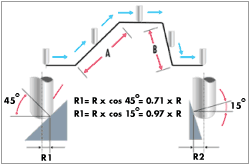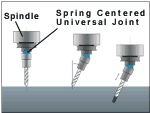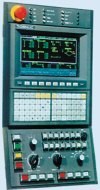What The Control Can Do
Mold and die makers know better than other sorts of shops that a machine tool's performance is determined by the electronics as much as by the iron.
Share





Mold and die makers know better than other sorts of shops that a machine tool's performance is determined by the electronics as much as by the iron. In order to cut at a fast feed rate along the complex contours characteristic of molds and dies, the CNC has to be able to process data fast enough to keep up with the frequent and rapid direction changes. That's why improved CNC performance is an important enabling factor for high speed machining. But is a faster feed rate all that a more powerful CNC can achieve?
Not at all. The increased processing power can also let the CNC coordinate separate moving parts of the machine tool more effectively than was possible before. This more precise coordination can bring brand new capabilities to conventional CNC machining centers.
One builder that illustrates this point is Toshiba Machine (Elk Grove Village, Illinois), a company that makes machining centers outfitted with its own "Tosnuc" CNC. Creatively harnessing the improved CNC performance available today has allowed this company to add a variety of special features to this control and thereby expand the range of applications in which its machines can perform effectively.
Three such features are described below. They all benefit mold and die shops in particular. The first feature has been available for some time, the second was introduced more recently, and the third is so new it has not yet been released.
What all of these capabilities have in common is that they change nothing about the design of the machine. The machining center's expanded functionality resides entirely within the control.
1. Better Ballnose Milling
One problem with a ballnose end mill is that a constant spindle speed can produce a wide range of cutting speeds. And where tool life, tool performance and surface finish are concerned, cutting speed is what really matters.
In other words, constant "rpm" produces widely varying values of "sfm" for these tools. The latter value depends on the contact point of the workpiece along the profile of the ball. (See illustration.) If you mill with a ballnose tool up and down over the landscape of a complex part at some constant spindle speed, the cutting speed can fluctuate significantly. One solution to this problem is a control feature Toshiba calls its "SF function." Through this feature, the control calculates the contact radius of the ball based on the angle of the tool path and overrides spindle rpm to maintain a constant speed at the edge. Thus, spindle speed essentially becomes one more servo-controlled parameter figured into the interpolated tool path, just like the linear motion in X, Y and Z.
Feed rate gets overridden, too. As the SF function modifies spindle speed, it has to modify feed rate in the same proportion in order to maintain a constant chip load. The payoff from this function is that the programmer no longer has to guess at a conservative value of spindle speed to ensure that cutting speed remains safe throughout a complex cut. Instead, the programmer can specify cutting speed directly...and let the control work toward this "sfm" target by continually calculating where the metal meets the ball.
2. Angle Drilling, No Indexing
Simple holes can add significant cost or delay to the process. A hole for venting, cooling or some other purpose can only be drilled conveniently on a conventional three-axis machining center if the hole is square with the rest of the work. Drill an angled hole, and—in general—either the work must be repositioned in another setup, or else the machine must be able to index the spindle or the work.
A feature of the Tosnuc control offers a third option. The control realizes angle-drilling capability that lets a three-axis machine drill rotary-axis holes without the expense of indexing hardware.
Precise interpolation is key. Also, another important component is a special pivoting toolholder that has no indexing power but does include a universal joint.
The joint is moved by the machining center. The machine advances so the spinning drill just touches the workpiece. Then, the machine moves through an interpolated circular arc to bend the toolholder's pivot to the angle intended without straining the drill. (See illustration.)
From there, straight-line interpolation allows the drill to penetrate along the proper diagonal.
The same feature permits synchronized tapping at an angle, too.
3. Milling An Internal Corner
Called "in-corner cutting," this control feature is in the final stages of development. When it's released, the capability will allow a machining center to mill out a "sharp internal corner that a typical shop today might only be able to produce through EDM.
In-corner cutting pushes coordinated machine motion to another level. As the spindle spins through one rotation, the rotary position of the spindle is continually coordinated with machine motion in X and Y. Look at the sequential diagram on this page to see what that means.
The diagram shows the special, solid-body, triangle-shaped tool necessary to take advantage of this function. The circle at the center of the triangle is the centerline of this tool and the centerline of the spindle. As the spindle spins through one rotation, the machine moves this centerline through a strict path in X and Y designed to control the course of the tool's cutting edges. The resultant path of the cutting edges lets them mill out a 90-degree corner.
If you have to ponder the diagram for a moment to see how interpolation can cut a corner, don't worry. This notion—producing an internal corner through milling—will strike many as bizarre.
However, that is why this capability offers such an effective illustration for how CNC functionality expands what a machining center can do. Letting the machine cut one more feature of the part that would otherwise require a different machine tool altogether may make it possible to eliminate a setup. In fact, in shops that have already achieved hard milling through the use of high speed machining, the addition of this cornering function may make it possible to eliminate the EDM machine itself.
Related Content
How to Achieve Unmatched Accuracy in Very Large Workpieces
Dynamic Tool Corp. purchases two bridge-style double-column CNCs to increase the cutting envelope and maintain 5-micron cutting accuracy in the long term.
Read MoreLyndex-Nikken Collets Enable Accurate Small-Diameter Cutting
The MMC Mini-Mini collet chuck is well suited for high-speed machining applications where clearance is needed, such as die mold, aerospace and medical parts.
Read MoreCimatron's Updated CAD/CAM Software Streamlines Mold Design
Eastec 2023: Cimatron V16 includes a clean new user interface and increased automation for faster mold design, electrode creation and NC programming.
Read MoreIn Moldmaking, Mantle Process Addresses Lead Time and Talent Pool
A new process delivered through what looks like a standard machining center promises to streamline machining of injection mold cores and cavities and even answer the declining availability of toolmakers.
Read MoreRead Next
5 Rules of Thumb for Buying CNC Machine Tools
Use these tips to carefully plan your machine tool purchases and to avoid regretting your decision later.
Read MoreBuilding Out a Foundation for Student Machinists
Autodesk and Haas have teamed up to produce an introductory course for students that covers the basics of CAD, CAM and CNC while providing them with a portfolio part.
Read MoreSetting Up the Building Blocks for a Digital Factory
Woodward Inc. spent over a year developing an API to connect machines to its digital factory. Caron Engineering’s MiConnect has cut most of this process while also granting the shop greater access to machine information.
Read More




















.jpg;maxWidth=300;quality=90)













